Cherry Blossom
RSP 11324
Grower: Yabba Cannaba
General Information
- Sample Name
- CG4
- Accession Date
- October 17, 2019
- Reported Plant Sex
- Female
- Report Type
- StrainSEEK v2 3.2Mb
- DNA Extracted From
- Stem
The strain rarity visualization shows how distant the strain is from the other cultivars in the Kannapedia database. The y-axis represents genetic distance, getting farther as you go up. The width of the visualization at any position along the y-axis shows how many strains there are in the database at that genetic distance. So, a common strain will have a more bottom-heavy shape, while uncommon and rare cultivars will have a visualization that is generally shifted towards the top.
Chemical Information
Cannabinoid and terpenoid information provided by the grower.
Cannabinoids
No information provided.
Terpenoids
No information provided.
Genetic Information
- Plant Type
- Type III
File Downloads
The bell curve in the heterozygosity visualization shows the distribution of heterozygosity levels for cannabis cultivars in the Kannapedia database. The green line shows where this particular strain fits within the distribution. Heterozygosity is associated with heterosis (aka hybrid vigor) but also leads to the production of more variable offspring. When plants have two genetically different parents, heterozygosity levels will be higher than if it has been inbred or backcrossed repeatedly.
The ratio of reads mapped to Y-contigs to reads mapped to the whole Cannabis genome (Y-ratios) has been demonstrated to be strongly correlated with plant sex typing. This plot shows the distribution of Y-ratios for all samples in our database which were sequenced with the same method (panel or WGS) as this sample and where this sample falls in the distribution.
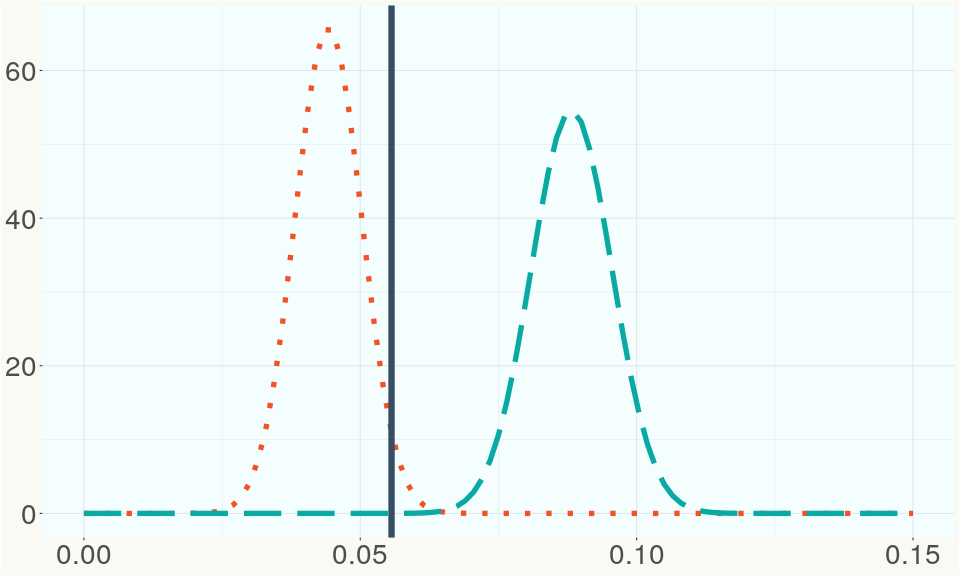
This chart represents the Illumina sequence coverage over the Bt/Bd allele. These are the three regions in the cannabis genome that impact THCA, CBDA, CBGA production. Coverage over the Active CBDAS gene is highly correlated with Type II and Type III plants as described by Etienne de Meijer. Coverage over the THCA gene is highly correlated with Type I and Type II plants but is anti-correlated with Type III plants. Type I plants require coverage over the inactive CBDA loci and no coverage over the Active CBDA gene. Lack of coverage over the Active CBDA and Active THCA allele are presumed to be Type IV plants (CBGA dominant). While deletions of entire THCAS and CBDAS genes are the most common Bt:Bd alleles observed, it is possible to have plants with these genes where functional expression of the enzyme is disrupted by deactivating point mutations (Kojoma et al. 2006).
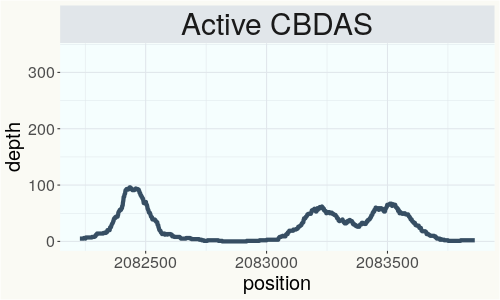
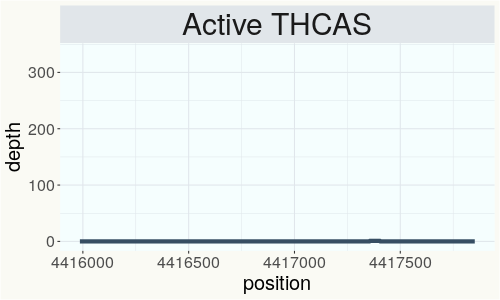
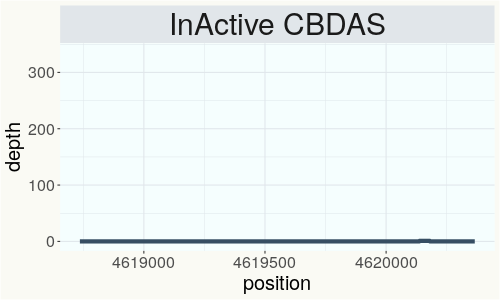
This chart represents the Illumina sequence coverage over the CBCA synthase gene.
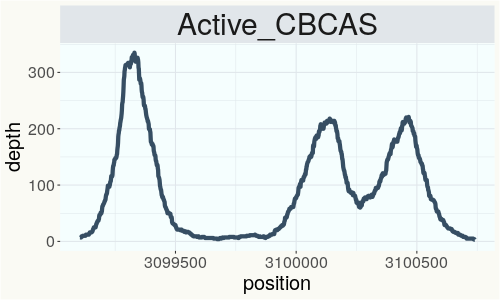
Variants (THCAS, CBDAS, and CBCAS)
Variants (Select Genes of Interest)
| PKSG-4a | c.493G>A | p.Gly165Ser | missense variant | moderate | contig700 | 1937904 | G/A |
|
| PKSG-4a |
c.1191_1193d |
p.Tyr398del | disruptive inframe deletion | moderate | contig700 | 1938600 | AATT/A |
|
| PKSG-2b | c.1117A>G | p.Ile373Val | missense variant | moderate | contig700 | 1950521 | T/C | |
| PKSG-4b | c.496A>G | p.Lys166Glu | missense variant | moderate | contig700 | 2721177 | T/C | |
| PKSG-4b | c.489delT | p.Phe163fs | frameshift variant | high | contig700 | 2721183 | CA/C | |
| PKSG-4b | c.485A>G | p.Lys162Arg | missense variant | moderate | contig700 | 2721188 | T/C | |
| PKSG-4b |
c.352_355del |
p.Thr118fs | frameshift variant | high | contig700 | 2721317 | CCTGT/C |
|
| PKSG-4b | c.324A>C | p.Glu108Asp | missense variant | moderate | contig700 | 2721349 | T/G |
|
| PKSG-4b | c.323A>G | p.Glu108Gly | missense variant | moderate | contig700 | 2721350 | T/C |
|
| aPT4 | c.97T>C | p.Tyr33His | missense variant | moderate | contig121 | 2828753 | T/C |
|
| aPT4 |
c.235_236del |
p.Val79fs | frameshift variant | high | contig121 | 2829030 | ATG/A |
|
| aPT4 | c.238delT | p.Ser80fs | frameshift variant | high | contig121 | 2829034 | AT/A |
|
| aPT4 | c.302A>G | p.Asn101Ser | missense variant | moderate | contig121 | 2829099 | A/G |
|
| aPT4 |
c.744+1_744+ |
splice donor variant & splice region variant & intron variant | high | contig121 | 2831022 |
GGTAATTTATTT |
|
|
| aPT4 | c.744G>A | p.Met248Ile | missense variant & splice region variant | moderate | contig121 | 2831022 |
GGTAATTTATTT |
|
Nearest genetic relatives (All Samples)
- 0.088 Cherry Blossom (RSP11333)
- 0.176 Cherry Blossom (RSP11331)
- 0.183 Cherry Blossom (RSP11299)
- 0.184 Cherry Blossom (RSP11302)
- 0.185 Unknown--Cherry Wine---005- (RSP11272)
- 0.187 Cherry Blossom (RSP11313)
- 0.206 Cherry Blossom (RSP11317)
- 0.214 Cherry Blossom (RSP11330)
- 0.222 Cherry Blossom (RSP11329)
- 0.225 Lift (RSP11378)
- 0.231 Cherry Blossom (RSP11332)
- 0.232 Electra (RSP11366)
- 0.233 Unknown--Cherry Wine---004- (RSP11271)
- 0.238 Cherry Blossom (RSP11334)
- 0.239 Cherry Blossom (RSP11325)
- 0.239 13 Cherries (RSP11442)
- 0.240 Cherry Blossom (RSP11320)
- 0.241 Cherry Blossom (RSP11308)
- 0.242 Cherry Blossom (RSP11326)
- 0.245 Cherry Blossom (RSP11335)
Most genetically distant strains (All Samples)
- 0.476 JL 3rd Gen Mother (RSP11214)
- 0.474 RKM-2018-002 (RSP11093)
- 0.474 Chem 91 (RSP11185)
- 0.473 JL yellow (RSP11075)
- 0.461 JL 4th Gen 5 (RSP11199)
- 0.456 RKM-2018-024 (RSP11116)
- 0.454 Sour Raspberry (RSP10551)
- 0.450 RKM-2018-018 (RSP11110)
- 0.450 Tanao Sri -46- (RSP11486)
- 0.448 JL 4th Gen 3 (RSP11195)
- 0.447 Herijuana (RSP11181)
- 0.447 Chematonic -Cannatonic x Chemdawg- (RSP11394)
- 0.446 OG BSR (RSP12105)
- 0.443 AVIDEKEL USA (RSP11169)
- 0.441 JL 4th Gen 6 (RSP11200)
- 0.441 Black Beauty (RSP11035)
- 0.439 Purple Strawberry AK47 1 1 (RSP11415)
- 0.439 Unknown--Cherry Wine---001- (RSP11268)
- 0.439 JL 3rd Gen Mother (RSP11197)
- 0.437 JL 4th Gen 2 (RSP11194)
Nearest genetic relative in Phylos dataset
- Overlapping SNPs:
- 66
- Concordance:
- 39
Nearest genetic relative in Lynch dataset
- Overlapping SNPs:
- 4
- Concordance:
- 4
Blockchain Registration Information
- Transaction ID
-
d22c7e4454ed9c70
585bd5834c6ab54f 16c186b098d12910 bfe59d9151598615 - Stamping Certificate
- Download PDF (847.2 KB)
- SHASUM Hash
-
a64d14f01327d4e61828eff1d707887d 81ea6d2c32a6686e dbcddd5d54a830a0